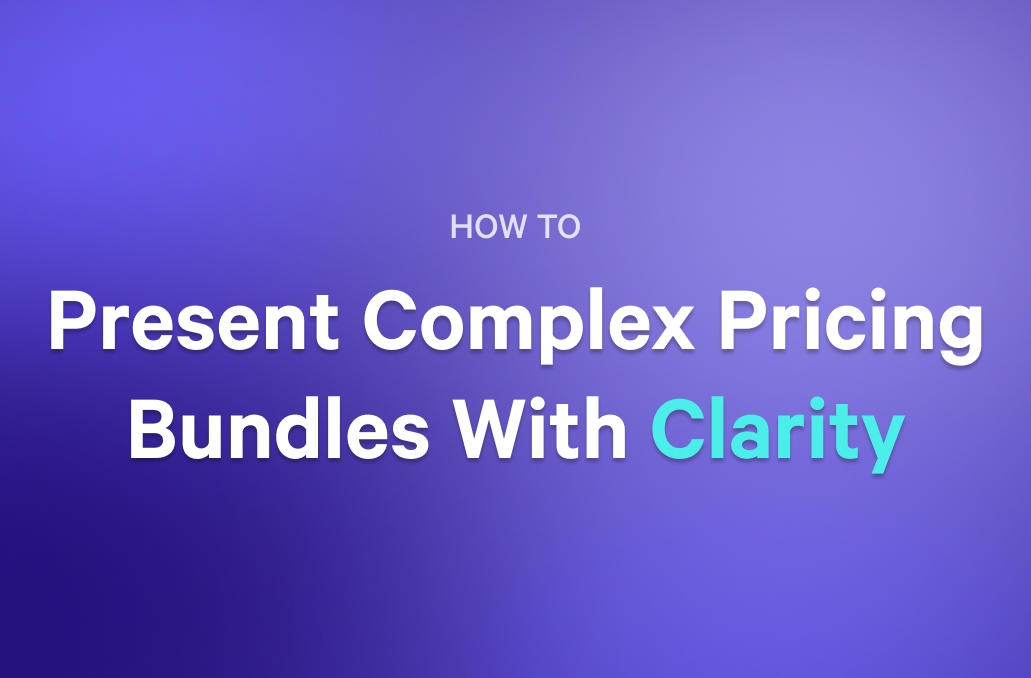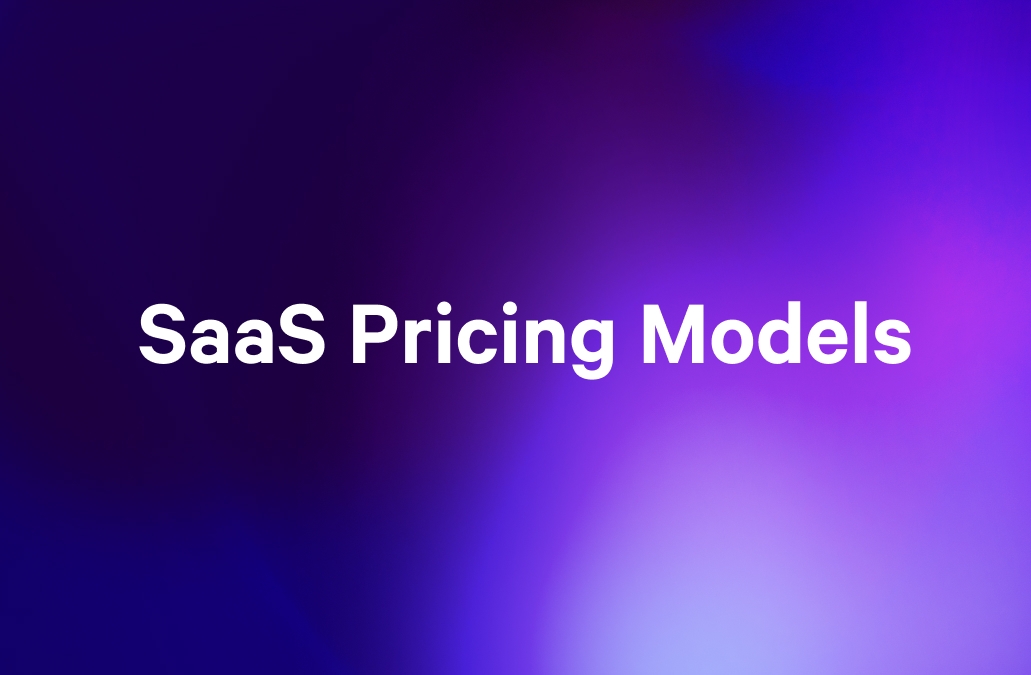Pricing. The word alone has probably caused more heated Slack debates, spreadsheets full of conditional formatting, and late-night existential crises than any other in the B2B world.
And for good reason: Harvard Business Review found that a mere 1% improvement in pricing can boost profits by over 11%. That’s a bigger return than increasing volume or cutting costs.
We’ll walk you through the major pricing models (with real talk on when to use them), sprinkle in some tips for how to present pricing beautifully in your proposals, and toss in a few jokes because, well, pricing is dry enough already.
Key takeaways
- From flat-rate to freemium, your pricing structure should match how your product delivers value.
- Adapt your pricing strategy. Market conditions change, your product evolves, and buyer expectations shift.
- Psychology sells: Use pricing tactics like anchoring, the rule of three, and decoy pricing to guide buyer decisions.
- Qwilr’s interactive pricing, real-time tracking, and beautiful proposal design help you showcase value clearly and close faster.
First, what is a pricing structure?
It’s not just the number you slap on your pricing page. A pricing structure is the strategic framework you use to determine how customers pay for your product or service. It includes:
- How much they pay
- What they’re paying for
- When they pay it
- And whether they cry while doing so
There’s no one-size-fits-all here: what works for a $10/mo meditation app won’t work for enterprise software that needs 3 months of onboarding and a dedicated CSM.
5 common pricing structures
1. Flat-rate pricing
Aka: The "We Like Things Simple" model
How it works: One product, one price
Best for: Products with clear value and minimal variation in customer usage
Examples: Basecamp, Netflix (until they start tinkering again)
Pros:
- Easy to understand
- Fast buying decisions
- You can probably fit it on a napkin
Cons:
- Leaves money on the table from power users
- Might scare away budget-conscious buyers
Qwilr tip: Flat-rate pricing shines in proposals where simplicity matters. With Qwilr’s pricing blocks, you can drop in a clear, no-nonsense quote that even your client’s procurement team will love.
Read next: How to write a pricing proposal that seals the deal.
2. Tiered pricing
Aka: The “Gold, Silver, Bronze”
How it works: Different packages at different price points. Usually tied to feature access, user seats, or usage limits.
Best for: SaaS companies, product-led growth strategies, and anyone who loves charts.
Examples: HubSpot, Canva, your local gym
Pros:
- Serves different customer segments
- Makes upselling feel less like upselling
Cons:
- Confusing if tiers aren’t clearly differentiated
- You will spend hours naming those tiers
Pro move: Use Qwilr’s interactive pricing to let clients explore different tiers directly in your proposal. It’s like a choose-your-own-adventure, but with less peril and more payment.

3. Usage-based pricing
Aka: The “You Pay for What You Use”
How it works: Customers are charged based on how much they consume: API calls, gigabytes, dog memes generated, etc.
Best for: Infrastructure tools, platforms, and products where usage varies widely
Examples: AWS, Twilio, Stripe
Pros:
- Scales with customer success
- Lower barrier to entry
Cons:
- Harder to predict revenue
- May terrify customers who fear surprise bills (hello, cloud computing)
Hot tip: Prevent deals from going cold. Use tracking in Qwilr to see when your prospect views the pricing section and how long they linger there. If they’re stuck on the usage-based table for 17 minutes…maybe it’s time to simplify.
With Qwilr’s interaction tracking, you’re no longer in the dark. Think of it as your sales X-ray: you’ll see exactly where buyers are moving forward, hesitating, or ghosting.
These insights cover key touchpoints in the pricing and acceptance journey, so you can stop guessing and start addressing friction before it stalls the deal.

And there’s more than just pricing. Here’s what Qwilr now tracks:
- Signature stalls: Instantly see who’s signed (hello e-signature perk) and who’s still dragging their feet.
- Acceptance in limbo: Know if the process has started, stalled, or is half-baked.
- Pricing tweaks: Get alerted when a quote’s been edited or customized.
- ROI calculator action: Find out if your buyer is crunching numbers or just window shopping.
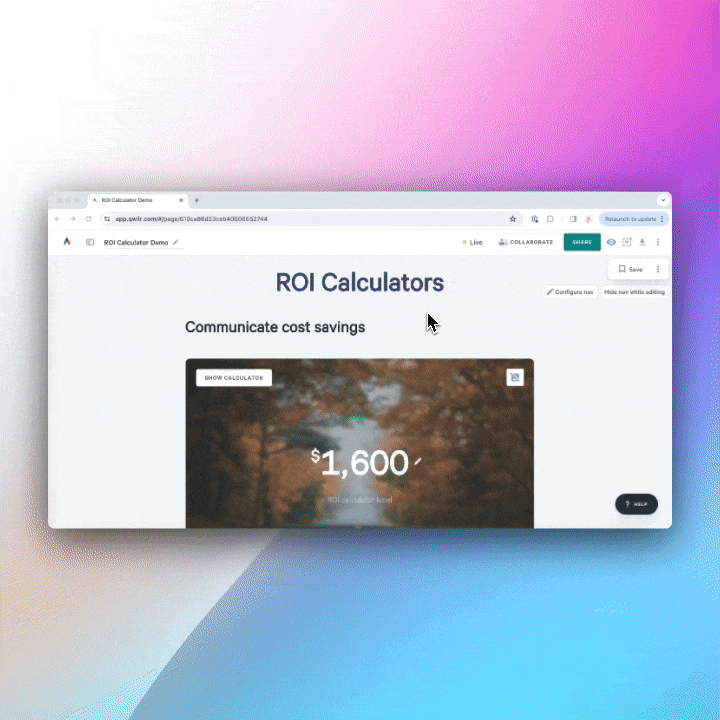
4. Per-user pricing
Aka: The “Let’s Count Seats Like It’s Musical Chairs” model
How it works: You charge based on the number of users/seats/licenses.
Best for: Collaboration tools, productivity apps, software used across teams
Examples: Slack, Zoom, Notion
Pros:
- Easy to forecast revenue
- Encourages team-wide adoption
Cons:
- Can create friction in scaling
- Teams might share logins (which is rude, Karen)
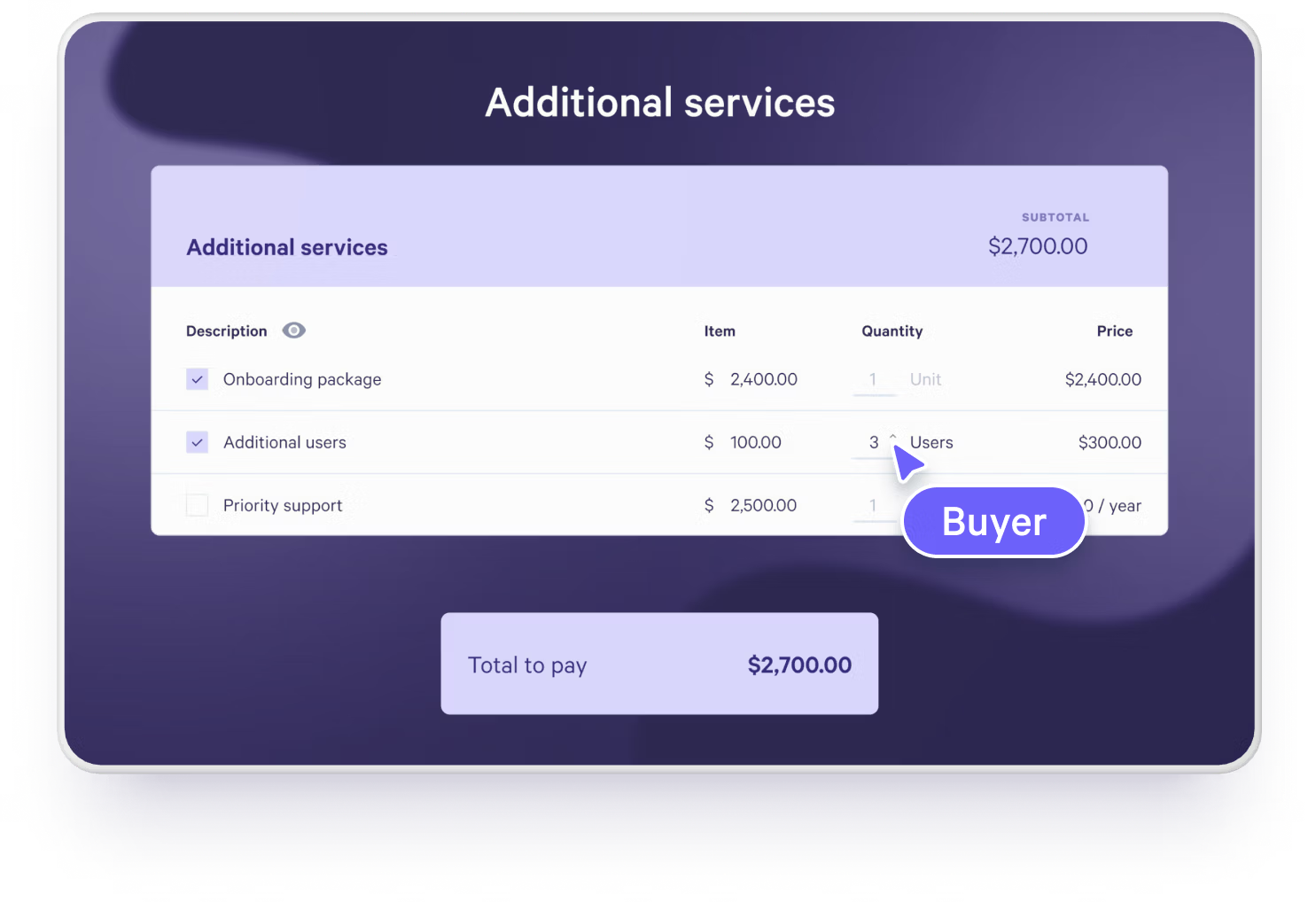
5. Freemium
Aka: The “Give Them a Taste and Hope They Come Back With a Credit Card”
How it works: Basic features are free forever, and advanced features require payment
Best for: Product-led growth, viral tools, and startups that enjoy walking the edge of profitability
Examples: Dropbox, Grammarly, Notion
Pros:
- Low barrier to entry
- Wide top-of-funnel
Cons:
- Monetization is tricky
- Free users may never convert (but still open support tickets)
Bonus Read: Ramp pricing guide
Common pricing pitfalls (And how to avoid them)
Even the most brilliant businesses can stumble when it comes to how they charge. The good news: most pricing problems are fixable, if you know what to look for.
Pricing based on costs, not value
Just because it costs you $30 to deliver doesn’t mean you should charge $35. That’s cost-plus thinking—and it leaves value out of the equation.
Instead, anchor your pricing to the outcome your customer gets. If you’re saving them $10,000 a month, charging $500 isn’t just fair, it’s a bargain.
"Set it and forget it" pricing
Markets shift. Competitors pivot. Your product evolves. But your pricing? Still clinging to that 2018 spreadsheet like a baby koala.
Treat pricing as an ongoing experiment. Revisit it quarterly. Test things. Iterate. After all, the only constant is change.
Overcomplicating it
If a customer needs a PhD to understand your pricing table, they’re not going to trust your software.
Simplify where you can. Use tooltips, clean tiers, and visuals that make the path to purchase feel frictionless.
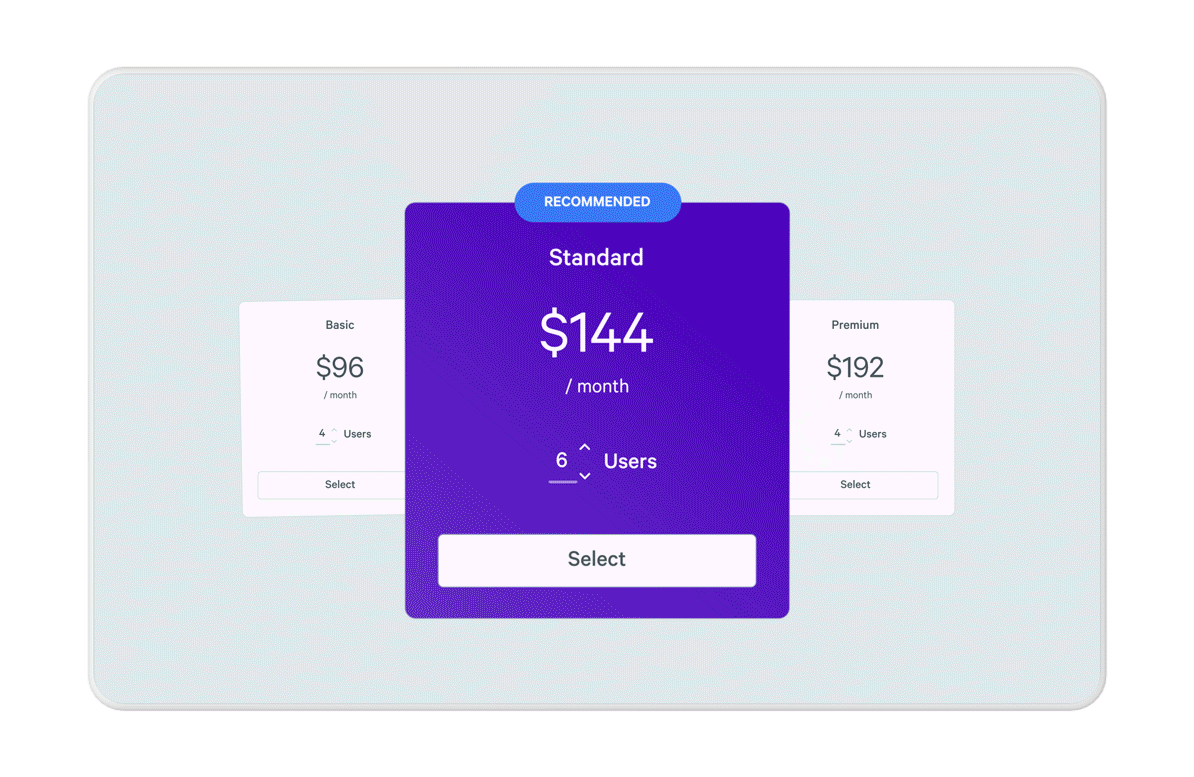
With Qwilr it's easy to communicate transparent, simple pricing that works for your prospects
How to choose the right pricing structure
If you're thinking, “Cool, there are lots of models, but which one do I choose?”—good question. Here’s a cheat sheet to help:
| Your business type | Try this pricing model | Why it works |
|---|---|---|
SaaS for teams | Per-user, tiered | Matches team growth, easy to forecast |
Infrastructure/API tools | Usage-based | Aligns values with scale |
Creative agencies | Flat-rate, project based | Clients want clarity, not meter-running fees |
Product-led startups | Freemium + tiered | Pull them in free, nudge them to upgrade |
Professional services | Value-based custom quotes | High-trust, high-touch - requires flexibility |
The golden rule? Match how you deliver value to how you capture value. And make sure your pricing feels fair to your customer, not just your CFO.
A few pricing add-ons to consider
- Anchoring: Present a high-tier option first to make the mid-tier look like a steal.
- Decoy pricing: Introduce a “meh” option to nudge people toward the one you want them to choose.
- Psychological pricing: $99 > $100. We’re all suckers for this.
- Localisation, currency, and global charm: If you’re serving international customers, your pricing structure should travel well. That means:
- Showing prices in local currencies
- Accounting for regional buying behavior
- Understanding what’s “expensive” in one market may feel like peanuts in another
A word to the wise: if your audience is global, consider pricing in other currencies.
A great new feature is QwilrPay – an integrated payment solution built directly into your Qwilr proposals and automated quotes.
Track completed and upcoming payments in one clear view. Monitor payment status across all your proposals. Instantly see which deals are paid, pending, or require attention. Easy!

Advanced move: layering pricing with sales psychology
This is where the black belts play. Your pricing page is a behavioral playground. Here’s how to use the psychology of sales to tilt the odds in your favor.
1. The rule of three
Humans crave contrast to make decisions. When you offer three pricing options — usually Basic, Pro, and Premium — you're guiding them into the middle tier (aka the "Goldilocks effect": not too basic, not too expensive, just right).
Make your middle option the hero. Highlight it visually. Use persuasive microcopy like “Most Popular” or “Best Value.”
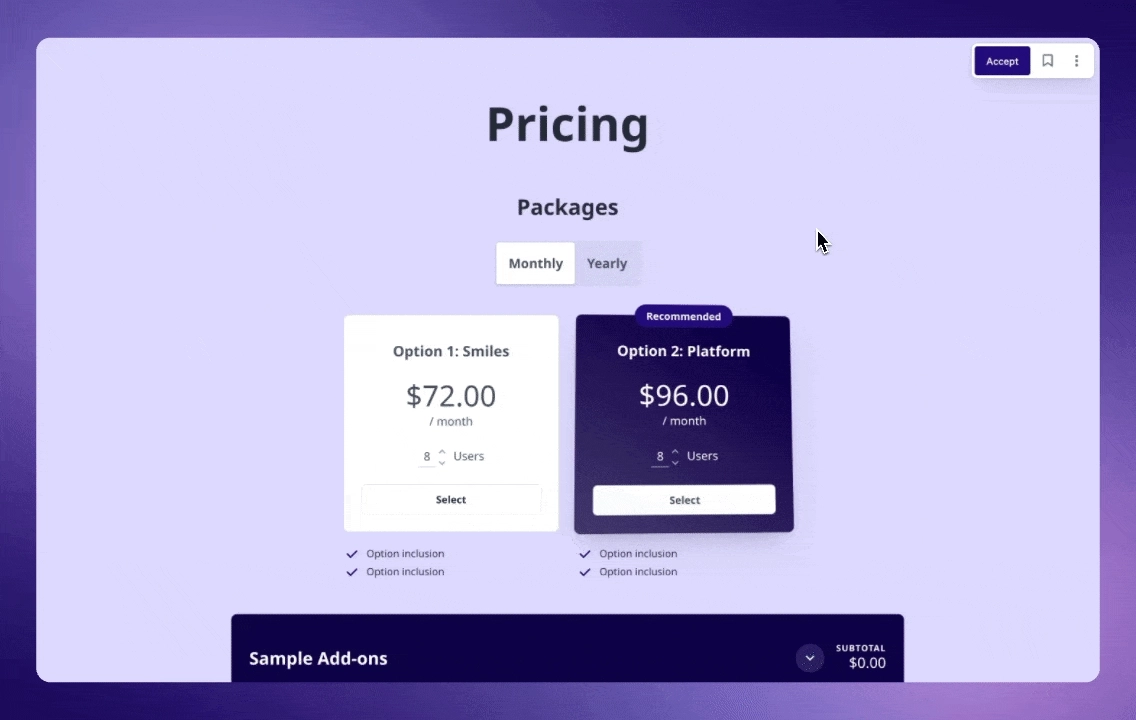
2. The endowment effect
People value things more when they feel ownership. Let buyers “build their own” plan by selecting features or adjusting usage levels: think sliders, checkboxes, or interactive quotes.
The more effort they put into customizing, the more likely they are to convert. It’s no longer your product. It’s their solution.

3. Loss aversion
We’re hardwired to avoid loss more than we’re driven to seek gains. So don’t just say what’s included, say what’s missing if they don’t go for the higher tier.
“Without Pro, you’ll miss out on real-time alerts, advanced integrations, and premium support.” Ouch. Better upgrade.
4. Anchoring
Start with your most expensive option to make everything else look like a deal. That high anchor sets a reference point that re-frames the value of your mid- and lower-tier options.
Example: Show the Enterprise plan first, then the Business and Starter plans feel like a steal.
5. Decoy pricing
Introduce a strategically “average” plan to nudge buyers toward your target tier. It’s the option that exists only to make another one look better.
Think: a basic plan that’s too limited or a premium tier that’s overpriced - both make the middle tier shine.
6. Social proof and scarcity
Layer on signals like “Over 2,000 businesses chose the Pro Plan” or “Only 5 spots left this quarter.” We hate missing out, and we love doing what others are doing.
Fear of missing out + herd mentality = conversion rocket fuel.
If you can make your pricing feel like the obvious and smartest choice, while making the customer feel in control, you're already halfway to a signed deal.
What to do when your pricing isn’t working
Sometimes, despite your best efforts, pricing falls flat.
Lots of interest, no conversions. Customers consistently choosing the lowest tier. Confusion during the sales process. Frequent discounting just to close.
If you're seeing signs like this, then it’s time for a pricing intervention.
Here’s what you can do:
1. Talk to your customers. Ask what they value and how they use your product.
2. Audit your competitors. Not to copy, but to understand the landscape.
3. Test new models.
4. Get uncomfortable. Sometimes pricing needs bold moves, not minor tweaks.
Make pricing a growth lever, not a guess
Maybe we should’ve mentioned this earlier, but there are great benefits to good pricing strategies. When you get it right, it can:
- Accelerate sales cycles
- Boost customer lifetime value
- Differentiate you in crowded markets
- Make your proposals practically close themselves (well… almost)
With Qwilr, you can make your pricing as dynamic, interactive, and beautiful as the rest of your business. So don’t just send a static PDF. Send something that sells.
What’s more, even the best pricing model can flop if it’s poorly presented. Here’s where tools like Qwilr can elevate your game:
- Interactive pricing blocks: Let buyers toggle options and instantly see how changes affect their total.
- Auto-calculated quotes: No manual math. No mistakes. No excuses.
- Real-time tracking: Know when your proposal is being viewed, and follow up while you’re still top of mind.
Your pricing structure is a product
Think of your pricing structure as something you build, test, and iterate on. It’s not a one-and-done decision. It evolves as your product matures, your market shifts, and your team realizes customers are smarter (and sneakier) than they expected.
So experiment. Ask your customers what they actually value. And remember: when in doubt, make your pricing look amazing and easy to understand in your proposals.
That part, at least, is a no-brainer with Qwilr. Sign up for a free 14-day trial and see for yourself.
About the author

Brendan Connaughton|Head of Growth Marketing
Brendan heads up growth marketing and demand generation at Qwilr, overseeing performance marketing, SEO, and lifecycle initiatives. Brendan has been instrumental in developing go-to-market functions for a number of high-growth startups and challenger brands.
